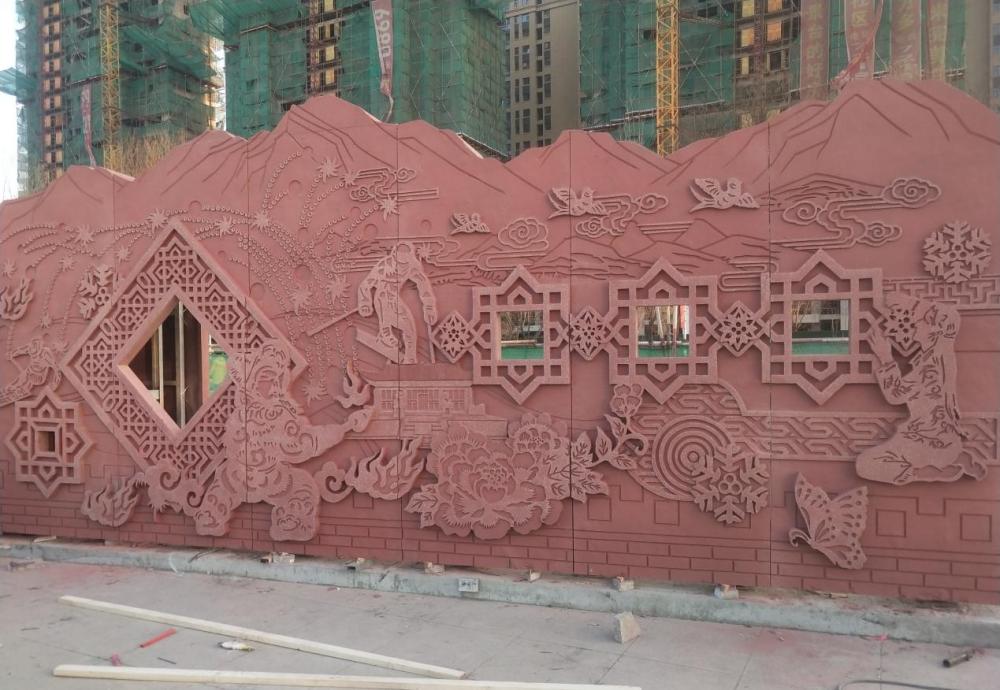"You see, this is the master of arts and crafts Zhang Precious using reconstructed stone, the introduction of paper-cutting art to create a hollow 'paper-cut culture wall', in the urban renewal to use it to separate the residential area and public areas, so that the people can see through the light, but also low-carbon and beautiful." In recent days, at the discussion meeting of the Economic Group 2 of the Fifth Session of the 13th CPPCC Municipal Committee, Wei Lianwei, member of the economic sector of the CPPCC Municipal Committee and secretary of the party committee and chairman of the board of directors of Beijing Gongmei Group, has repeatedly posted photos of the "paper-cut cultural wall" built by Gongmei Group's counterpart to help Wei County, Hebei Province, and has received a lot of praise.

Paper-cut culture wall photo
Around the "paper-cutting cultural wall", Wei Lianwei brought a proposal this time, suggesting the application of low-carbon technology in urban renewal and transformation to enhance the charm of urban culture and art. In the process of urban renewal and transformation in the past two years, Wei Lianwei paid attention to the fact that the transformation has effectively improved the living environment and safety conditions in the core areas of bungalows (courtyards), dangerous old buildings, shantytowns and other areas, but there are still places that need to be further improved. "For example, the large number of solid walls used to divide the living area and the public area is not beautiful, but also makes the residents' courtyard opaque, impermeable, impermeable, impermeable, and impervious, affecting the living feeling and quality of life, and some people have responded that 'this wall is very blocked'." Wei Lianwei gave an example.
In addition to being unsightly and affecting the living experience, solid walls also consume materials, which is not conducive to low-carbon emission reduction. In this regard, Wei Lianwei suggested that new environmentally friendly alternative materials for solid walls should be developed and further improved the effect of urban renewal and transformation. After many investigations, the national patented product of Beijing arts and crafts master Zhang Precious for many years of research and invention - reconstructed stone has entered Wei Lianwei's vision. "Re-engineered stone is a new type of lightweight and environmentally friendly decorative material made of solid waste such as stone slag powder, waste concrete, old bricks, etc., which has the characteristics of low-carbon emission reduction, decoration and strong sense of sculpture. At the same time, the material can use skeletonization technology to solve the problem of 'opaque, impermeable, impermeable green, not transparent'. Wei Lianwei introduced that at present, this material has been widely used in nearly 100 national key projects such as the Central Gift and Cultural Relics Management Center, the National Centre for the Performing Arts, the National History Museum, and the Diaoyutai State Guesthouse.
Recently, Beijing Gongmei Group cooperated with the People's Government of Weixian County, Hebei Province and Master Zhang Precious to create an urban cultural landscape space in Weixian County, and applied reconstructed stone materials. It is worth mentioning that the project will be a national intangible cultural heritage of Weixian County - paper-cutting, which is an excellent traditional culture and urban space and green and low-carbon organic combination, to create a "paper-cutting cultural wall" has become a beautiful local cultural landscape.
With the photo of the "paper-cut cultural wall", Wei Lianwei hoped that in the future, similar low-carbon technologies could be applied in the urban renewal and transformation of old residential areas, old factories, shantytowns, bungalows (courtyards) in the functional core area of the capital, and other urban renewals, and injected ancient capital culture, red culture, Beijing flavor culture, innovative cultural elements, and create a beautiful urban cultural landscape that integrates the unique charm of Beijing arts and crafts.